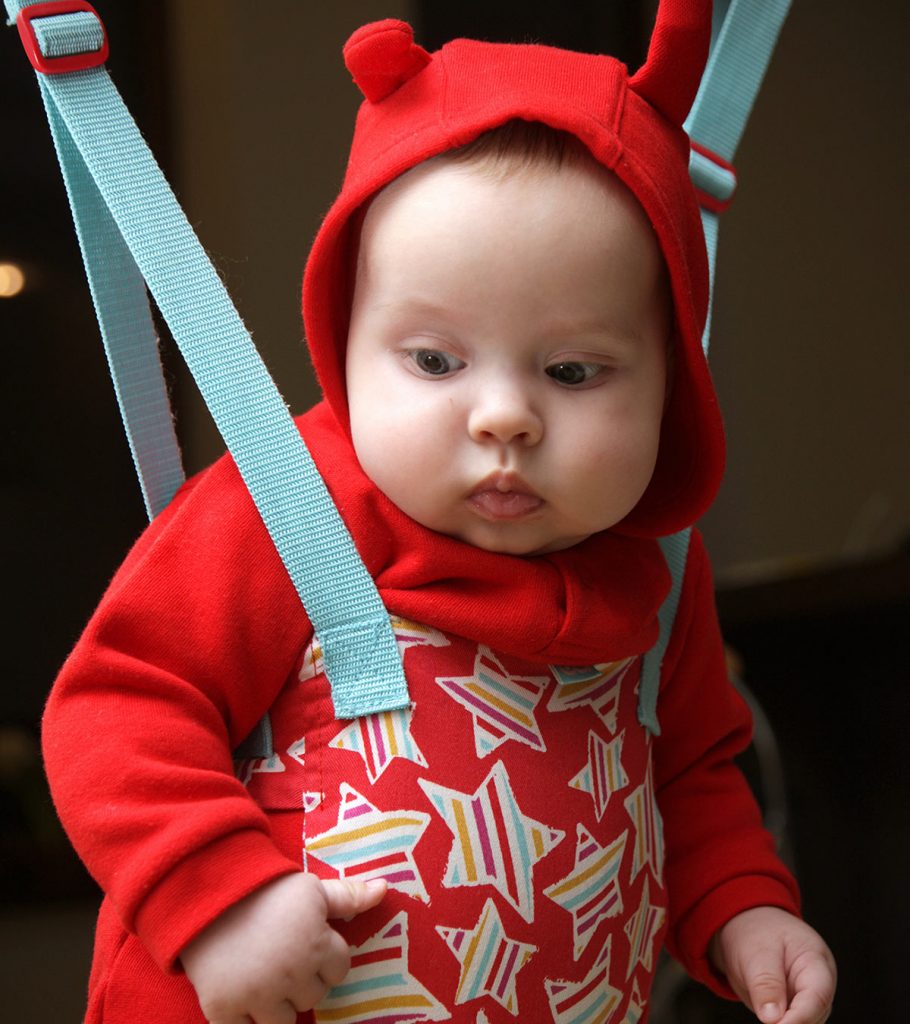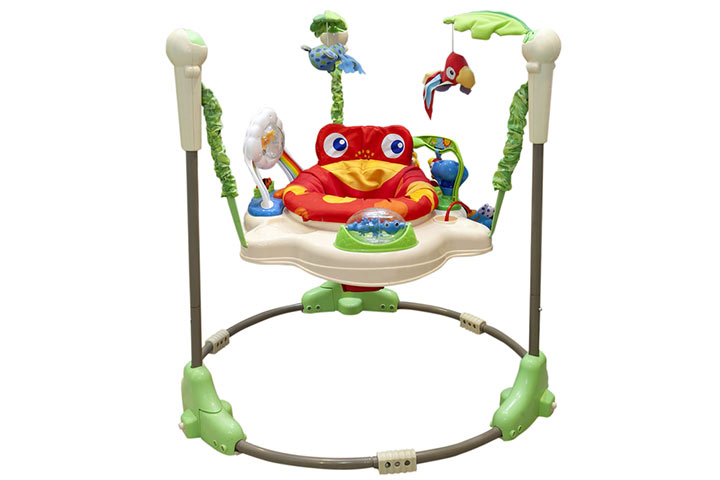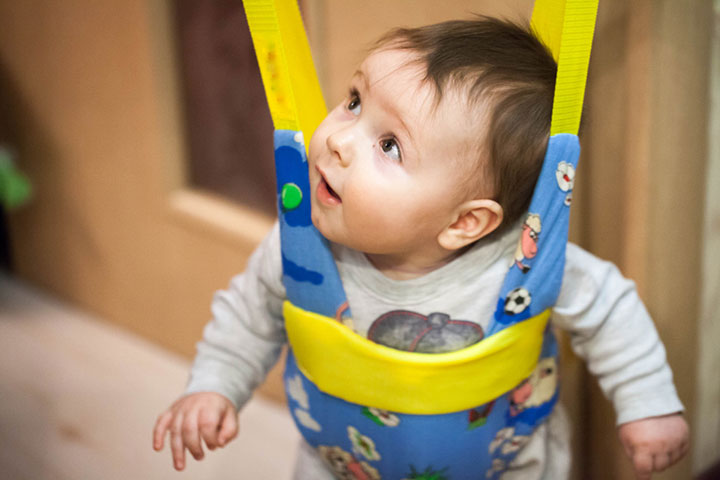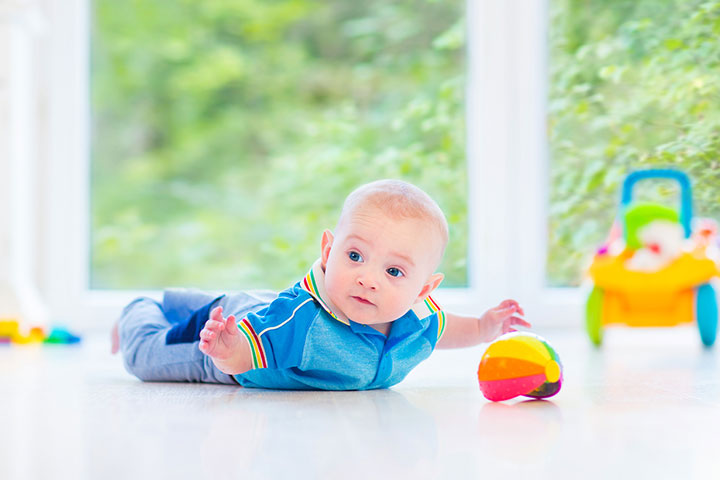Baby jumpers are fun toys that help them exercise, play, and jump. They are a sling-style seat suspended from a rubber cable with a spring that can be clamped above the door or toy frame itself. The baby pushes their feet against the floor to bounce in it. Parents may prefer these jumpers to keep the baby engaged and playful, but are these jumpers safe for babies? Scroll down to know more about the different types of jumpers, risks, alternatives, and safety tips for using jumpers in babies.
Are Baby Jumpers Safe?
Research studies have shown that baby jumpers are not safe for infants. Instead, the use of stationary play stations is recommended (1).
Different Types Of Baby Jumpers
Most jumpers feature an attached spring or springs that facilitate the bouncing and jumping motion. The following are the common types of jumpers available in the market.
1. Baby jumper that attaches to a door frame
It is a hanging toy with a sling-style seat that is attached to the frame of the door through a spring or a rubber cable. When the baby’s feet touch and slightly push the floor, the jumper begins to bounce. This is considered to be the least safe of all types of jumpers.
2. Stationary baby jumper with springs suspended from frames
It contains a sling-style seat suspended from springs from the frame of the jumper. The baby pushes the feet to initiate the bouncing while the frame bears the movement. The springs are usually covered with fabric covers.
3. Baby jumper with springs beneath the seat
The baby jumper contains a spring attached beneath the seat instead of it being suspended from a spring above.
The second and the third variants are considered relatively safer than the first one due to their stationary nature. But, in general, all jumpers bring some risks with them and hence are not recommended for infants.
When Can You Put Your Baby In A Jumper?
Use the jumpers only after the baby gains better head control. Babies begin to develop initial head control by the time they are three months old. However, they gain complete head control only by the time they are five to six months old (2). So, basically use them when the baby is six months or so.
What Are The Risks Of Using A Baby Jumper?
Although the babies might enjoy it, jumpers may not be ideal for the following reasons (1).
- Experts warn that prolonged use of baby jumpers increases the risk of developmental hip disorders such as hip dysplasia or dislocation. The jumper’s fabric seat can place the baby’s hips in an uncomfortable position, potentially straining the hip joint. Studies have reported delayed walking in babies who regularly spend 15 minutes or longer in the jumper.
- The jumpers suspended from the door frame can move from side to side. This motion poses a risk of the baby colliding with the door frame. Incorrectly attached jumpers can detach from the frame and increase the risk of injuries by the baby falling down.
- Improper installation, improperly functioning of the parts, weak door frame, incorrect securing to the doorframe, etc., can all lead to mechanical failure.
- Head injuries are the most common injuries that might occur due to bouncers or jumpers. These injuries typically occur when the baby bounces too hard or leans and falls forward out of the jumper (3).
- Excessive time in jumpers makes the baby stand more on their toes, thereby leading to calf muscle tightness.
- Babies might also accidentally pinch their fingers between the springs, chains, or the frame of the jumper.
- The jumper might break if the baby’s weight is more than the maximum permissible weight limit. It can cause severe head injuries, spinal injuries, or injuries to limbs, etc.
- Elder siblings in the house might push the jumper hard or try to climb along with the baby, thus causing the risk of the jumper breaking apart.
If you still want to use a jumper occasionally, wait until the baby is six months old and take safety measures.
Tips For Safe Use Of A Baby Jumper
If your baby loves the jumper, then the following tips can help you limit the associated risks and dangers (4).
- Use the baby jumper only after your baby has developed optimal head support i.e., six months. Some babies can take longer than others.
- Use a good quality branded baby jumper only. Make sure the jumper is strong.
- Select a door frame that is sturdy enough to take the weight of the jumper and the baby.
- Follow the manufacturer’s instructions carefully while installing the baby jumper.
- Do regular checks of the jumper to make sure all the safety features are intact and functioning properly.
- Fit the baby snugly into the jumper and fix all the straps well so that the baby does not fall out while jumping.
- Do not let the baby jump in it for more than 15 minutes a day.
- Keep a close eye on the baby while they are in the jumper. Do not leave the child unattended.
- Educate the baby’s elder siblings not to push the jumper or use it themselves.
- Promptly replace any worn-out or damaged straps of the jumper.
- Cover the exposed chains and springs with a fabric cover to prevent the baby’s finger from getting pinched.
- Adjust the jumper in a way that the baby’s feet touch the ground even when they are not jumping in the jumper.
- When not in use, remove the jumper from the door frame.
What Are The Alternatives To Baby Jumpers?
Indoor play equipment such as a stationary play gym or activity center for your baby can also aid in the physical aspect of child development. Tummy time on the floor is also an alternative and can provide the following benefits (5) (6).
- It helps strengthen the baby’s neck and back muscles.
- A baby might learn to crawl faster.
- They might learn to use their limbs better.
- It might help develop better trunk and leg support.
Therefore, instead of jumpers or walkers, use a stationary activity center.
Baby jumpers are one of the popular infant toys that allows kids to exercise and play. They come in different styles, including doorway jumpers with adjustable height, stationary baby jumpers with springs suspended from frames, and baby jumpers with springs beneath the seat. While they may provide entertainment for babies, they are not without hazards and drawbacks. So, if you’re going to use a baby jumper, make sure you take all the essential measures when setting it up and using it.
Key Pointers
- Before using a jumper for your baby, ensure that their head and neck control has developed.
- Do not leave your baby unattended while they are in the jumper.
- Monitor the amount of time your baby spends in the jumper to prevent overuse.
- Be aware of the height limit that is advertised by the jumper’s manufacturer.
- Regularly inspect the jumper for signs of wear and tear.
Don’t buy baby walkers, push walkers or jumpers! A physiotherapist explains why they can be dangerous for your baby’s development.















